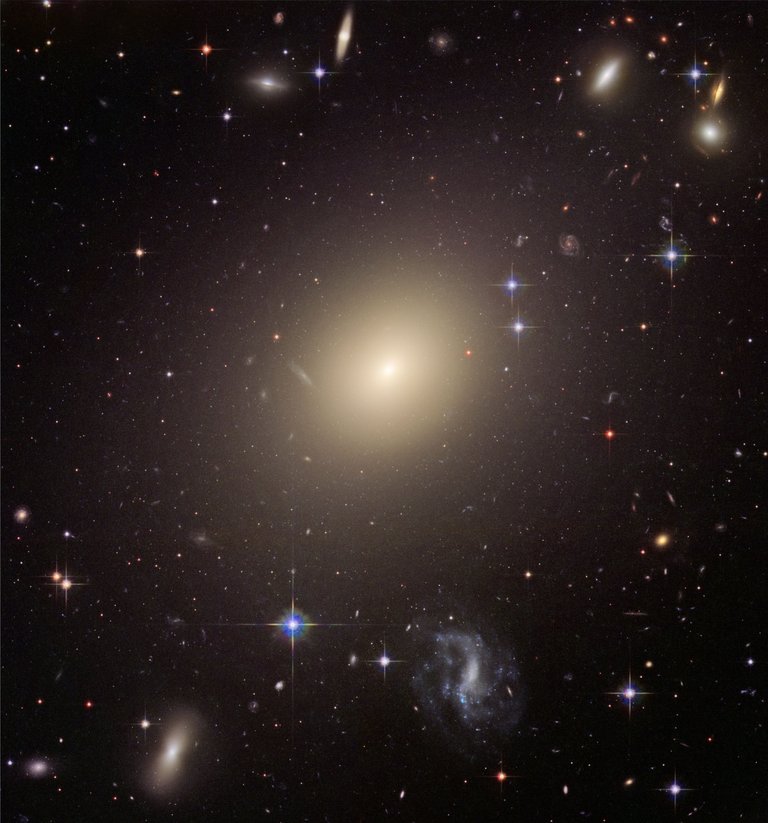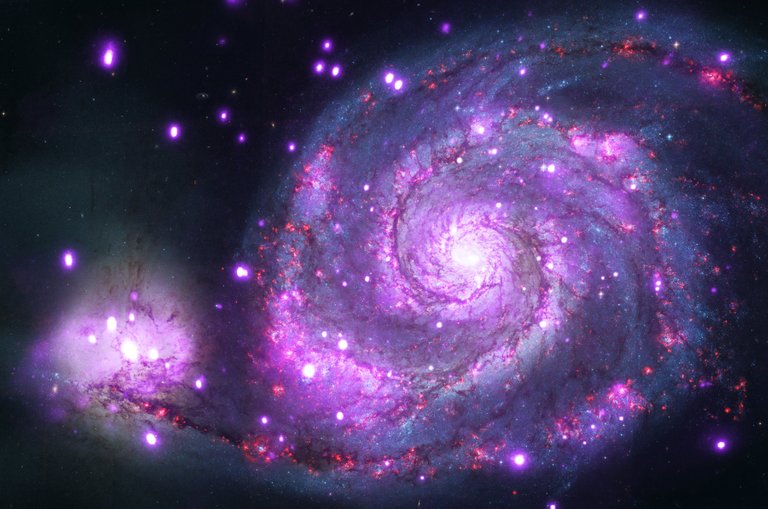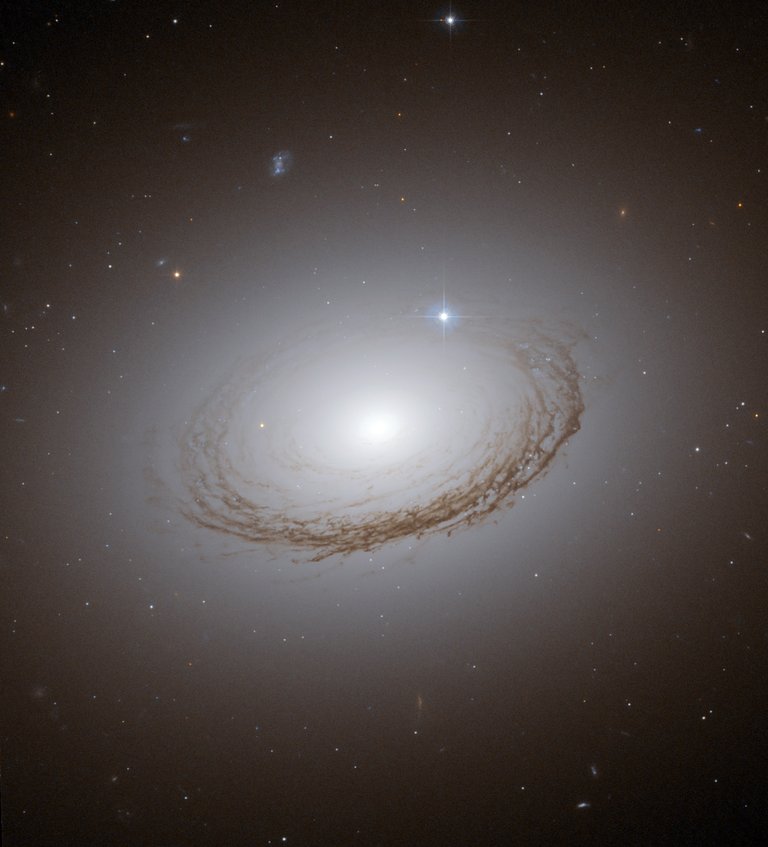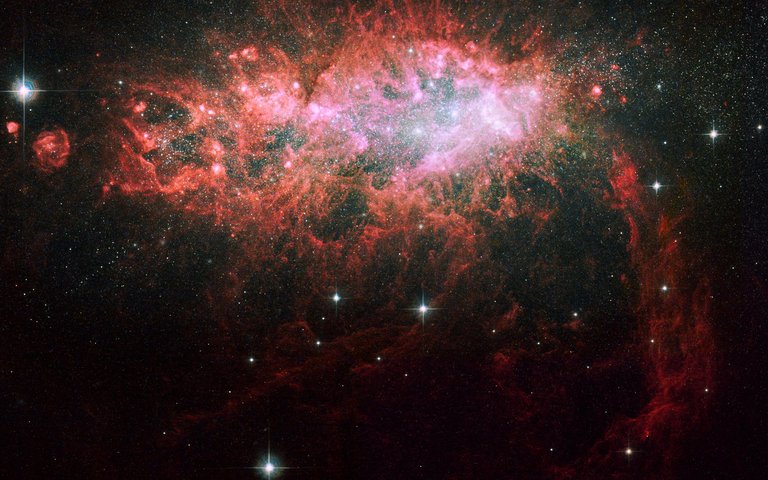Elliptical galaxy.
From the side it looks like a giant star - a glowing ball with the strongest brightness in the center and dimming to the edges. Elliptical, or spheroidal galaxies are almost entirely composed of old stars, so they always have a yellow or reddish tinge. New stars are hardly formed in them, since the amount of interstellar gas and dust in them is negligible (although there are exceptions). The elliptic stellar systems differ only in size and degree of compression. It is by compression that they are classified, from E0 to E7. About a quarter of the number of visible galaxies. According to Hubble's classification, this is the initial stage of galactic evolution.

Source Elliptical galaxy ESO 325-G004 / © NASA / ESA.
Spiral Galaxy.
The most common type and, probably, the most beautiful - is more than half the number of all known galaxies. It looks like a disk with a bright yellow ball in the center, around which in the form of spirals more dull branch-sleeves of bluish tint are twisted (due to the presence of special stars - white and blue supergiants).
From elliptical star systems is characterized by a number of structural features. First, spiral galaxies have sleeves, where active star formation takes place. Secondly, there is a stellar disk - a relatively thin layer of matter along the plane of the galaxy, where the main mass of objects of the system is located, and the stars in which rotate around the center of the disk. Thirdly, the presence of interstellar gas and dust is widely observed, which is necessary for the generation of stars in the medium. Many spiral galaxies have in their center a peculiar jumper (bar), from which ends sleeves diverge. Classify by the letter S and differ in the density of the location of the hoses (Sa-Sd, with a jumper - SBa-SBd).

Source Spiral galaxy Whirlpool and its companion NGC 5195 / © NASA
The number of sleeves averages a couple, but there are more; in some cases the sleeves differ in size. All of them (if they do not survive the galactic collision) are twisted in one direction around the center, where the bulk of the matter is concentrated in the form of a supermassive black hole and a dense spherical cluster of old stars - the bulge.
And our galaxy is the Milky Way, and the Andromeda Nebula, which we will inevitably face in 4 billion years, both are spiral galaxies. The sun is between the arms and far from the galactic center, and the speed of its movement is approximately equal to the speed of rotation of the arms; Thus, the solar system avoids dangerous areas of active star formation for earthly life, where supernovae often break out.
Lenticular Galaxy.
According to Hubble's classification, this is an intermediate type between elliptical and spiral galaxies (S0). Lenticular stellar systems have a stellar disk around the central globular cluster-bulge, however the sleeves are relatively small and not very pronounced, and the amount of interstellar gas dust matter is not sufficient for the active production of new stars. The main inhabitants are old big stars, red or yellow.

Source Lenticular Galaxy NGC 7049 / © NASA / ESA
Differences in the number of interstellar dust and density of the bridge in the galactic center. They make up about 20% of the number of galaxies.
Wrong galaxy.
Neither an ellipse, nor a spiral - irregular galaxies do not possess any of the common forms. As a rule, it is chaotically connected by gravity star clusters, sometimes not having a clear form and even a pronounced center. About 5% of galaxies make up.
Why are they so different from their galactic counterparts? It is very likely that each such stellar system was once elliptical or spiral, but it was disfigured by a collision with another galaxy, or a close neighborhood with it.

Source NGC 1569 is a dwarfish irregular galaxy in the constellation Giraffe / © NASA / ESA
They are divided into two main types: those who have at least some kind of structure that allows them to be attributed to the Hubble sequence (Irr I), and those who do not even have the likeness (Irr II).
Sometimes a third type is distinguished - dwarf irregular galaxies (dl or dIrr). They have a low amount of heavy elements and a large amount of interstellar gas, which makes them similar to the protogalaxy of the early Universe. Therefore, the study of this kind of irregular galaxies is important for understanding the process of galactic evolution.
So happy I read this. So much better than Wikipedia :).
Thanks!
)))))) ок!
img credz: pixabay.com
Nice, you got a 98.0% @welcomebot upgoat, thanks to @kuku12170
It consists of $0.56 vote and $0.19 curation
Want a boost? Minnowbooster's got your back!
To call @OriginalWorks, simply reply to any post with @originalworks or !originalworks in your message!